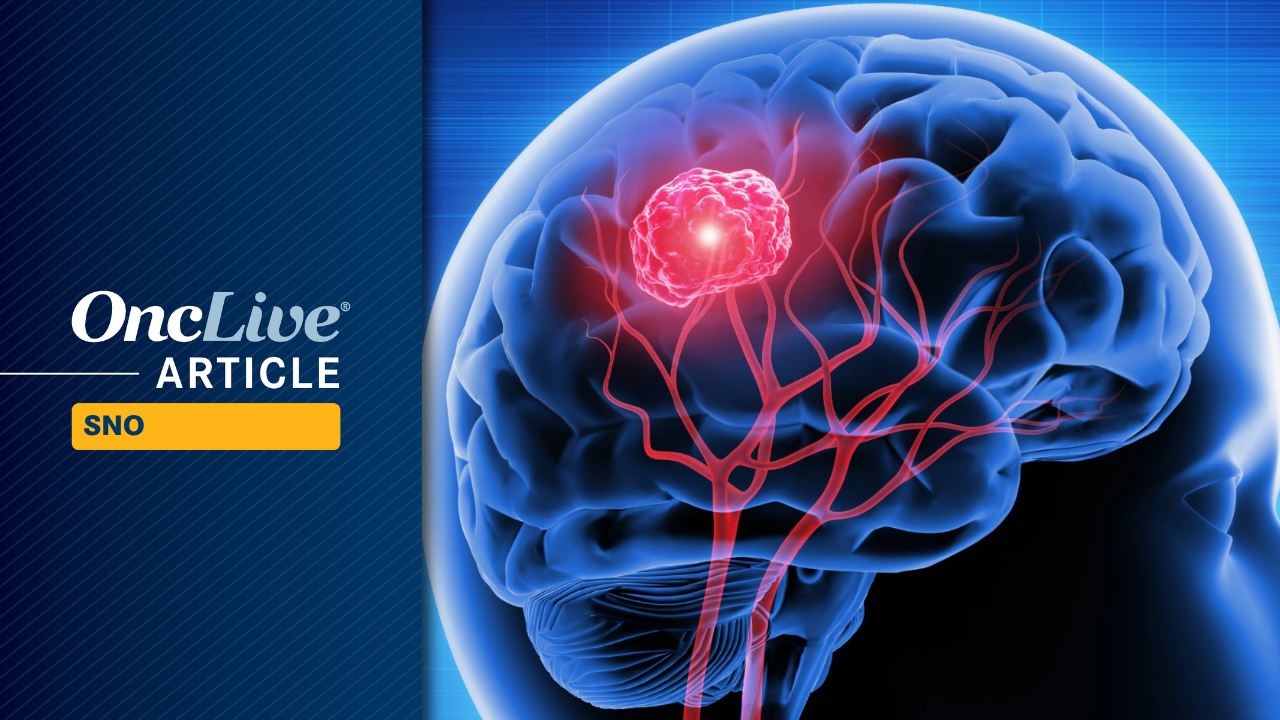The addition of temozolomide (Temodar) to radiotherapy improved overall survival (OS) and progression-free survival (PFS) vs radiotherapy alone in patients with IDH-mutant, symptomatic or progressive low-grade glioma (LGG) without codeletions of 1q and 19q, as well as patients with codeletions, according to findings from a molecular analysis of the phase 3 ECOG-ACRIN E3F05 trial (NCT00978458), which were presented at the
A statistically significant OS benefit with the addition of temozolomide to radiotherapy vs radiotherapy alone was seen among patients with IDH-mutated disease without codeletions (n = 38; HR, 0.15; 95% CI, 0.03-0.74; stratified log-rank P = .02). An OS benefit was also seen among patients with codeletions (n = 74; HR, 0.51; 95% CI, 0.19-1.42). Numerical PFS benefits were also seen among patients without codeletions (HR, 0.50; 95% CI, 0.16-1.54) and those with codeletions (HR, 0.57; 95% CI, 0.24-1.35).
“These numbers were too small to allow us to declare statistical significance,” lead study author David Schiff, MD, said of the findings in the population of patients with codeletions during the presentation.
Schiff is the Harrison Distinguished Professor of Neurology, Neurological Surgery and Medicine in the Department of Neurology, Division of Neurology at the University of Virginia (UVA), as well as the codirector of the UVA Neuro-Oncology Center in Charlottesville.
ECOG-ACRIN E3F05 Trial Key Highlights
- The ECOG-ACRIN E3F05 trial investigators performed methylation profiling to determine IDH mutational status in enrolled patients following trial closure.
- The addition of temozolomide to radiotherapy provided a statistically significant OS benefit compared with radiotherapy alone for patients with IDH-mutant LGG who did not have codeletions of 1q and 19q (HR, 0.15; 95% CI, 0.03-0.74; stratified log-rank P = .02).
- Among patients with IDH-mutated, non-codeleted disease, the 10-year OS rate was higher in the temozolomide plus radiotherapy arm (80%) compared with the radiotherapy alone arm (39%).
What was the design of the ECOG-ACRIN E3F05 trial?
E3F05 enrolled patients at least 18 years of age with grade II glioma who had receive no prior radiotherapy or chemotherapy. Patients also needed to be younger than 40 years of age or have radiographic progression or have uncontrolled symptoms/seizures. Following surgery, patients were randomly assigned to receive radiotherapy at 50.4 Gy alone or with concomitant temozolomide followed by 12 cycles of temozolomide on days 1-5 of each 28-day cycle. After study treatment, patients underwent follow-up.
Patients were stratified by age, deletion 1q/19q status, Karnofsky performance score, tumor diameter, and contrast enhancement.
How has the E3F05 trial evolved as glioma classification systems have changed over time?
The E3F05 trial was activated in September 2009, which Schiff noted was prior to the advent of IDH testing in glioma. In January 2014, updated findings from the phase 2 RTOG 9802 trial (NCT00003375) of radiation with or without procarbazine/lomustine/vincristine chemotherapy in patients with LGG showed a benefit with the addition of chemotherapy, making the control arm of E3F05 unethical. At that point, accrual to E3F05 was stopped with 172 of the planned 540 patients enrolled.
“These non-codeleted tumors were agnostic as to their IDH [mutation] status and were 2 World Health Organization classification systems past what we started with when the study was conceived,” Schiff explained. “To try to ascertain IDH mutational status to characterize…patients according to contemporary neuropathology, we reached an agreement with the National Cancer Institute…database group to perform methylation profiling on our patients.”
Among the 172 enrolled patients, 74 had codeletions. Additionally, 97 patients had adequate samples for methylation profiling, 52 of whom did not have codeletions. Among those 52 patients, Heidelberg v12 classification was used to determine that 13 had IDH wild-type disease (diffuse high-grade subtype F, n = 3; glioblastoma, n = 2; ganglioglioma, n = 2), and 38 had IDH-mutant diffuse glioma (IDH-mutant low-grade astrocytoma, n = 36; IDH-mutant high-grade astrocytoma, n = 2).
What efficacy data from E3F05 have been previously reported?
Efficacy findings that were
What additional updated efficacy data from E3F05 were presented at SNO 2025?
Among the patients with IDH-mutated, non-codeleted disease, the 5-year PFS rate was 76% in the temozolomide arm vs 53% in the radiotherapy alone arm.1 The 10-year PFS rate with temozolomide was 59%. At 5 years, the OS rates were 94% with temozolomide plus radiotherapy and 71% with radiotherapy alone. These respective rates at 10 years were 80% and 39%.
“The benefit of adding temozolomide in the IDH-mutant astrocytomas is particularly evident when you look at 10-year OS with radiation alone,” Schiff added.
Among the patients with codeletions, the 5-year PFS rate was 79% in the temozolomide arm vs 64% in the radiotherapy alone arm. The 10-year PFS rates in these respective arms were 47% and 69%. At 5 years, the OS rates were 97% with temozolomide plus radiotherapy and 92% with radiotherapy alone. These respective rates at 10 years were 90% and 68%.
“In summary, we’ve shown a statistically significant OS benefit with the addition of temozolomide to radiation in grade 2 IDH-mutant astrocytomas, and we still see a trend toward [an] OS benefit in the oligodendrogliomas as well,” Schiff concluded. “We [also] see suggestive HRs for PFS in both the astrocytomas and oligodendrogliomas.”
References
- O’Neill A, Brown P, et al. Molecular analysis of outcomes in ECOG-ACRIN E3F05: phase III study of radiation therapy with or without temozolomide of symptomatic or progressive low-grade gliomas. Presented at: 2025 SNO Annual Meeting; November 19-23, 2025; Honolulu, Hawaii. Abstract CTNI-29.
- Schiff D, O’Neill A, Brown P, et al. LTBK-07. Progression-free and overall survival results of ECOG-ACRIN E3F05: a phase 3 intergroup trial of radiation ± temozolomide for grade II gliomas.Neuro Oncol. 2024;26(suppl 8):viii1-viii2. doi:10.1093/neuonc/noae165.1303
